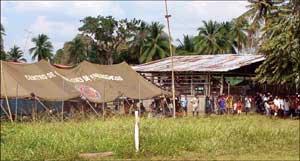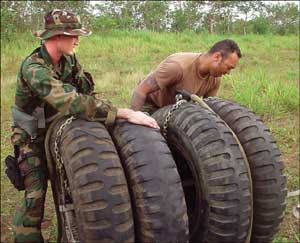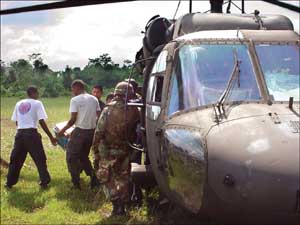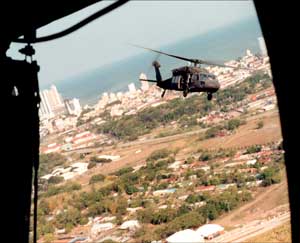 Rebel forces, humanitarian missions, flying over a
place that isn’t New Jersey.
All in days work for the 1-150th General Aviation
Support Battalion.
Rebel forces, humanitarian missions, flying over a
place that isn’t New Jersey.
All in days work for the 1-150th General Aviation
Support Battalion.
From Jan. 13 through May 8, the 1-150th deployed three UH-60A Blackhawk helicopters and 60 Guardsmen for Operation New Horizons 03, Joint Task Force Chiriqui. The mission of Joint Task Force Chiriqui, named after the Republic of Panama province the base was set up in, was to construct schools and clinics and practice medicine to benefit the villagers in the remote mountain region.
 The big test came almost immediately upon the 150th’s
arrival. With just nine days in country, the Battalion was
being sent to an area where right-wing Columbian rebels
had driven hundreds of people out of their village.
On Jan. 22, the New Jersey Guardsmen were told at the
Office of Defense Cooperation (ODC) that the Panamanian
Government had requested humanitarian airlift support.
Right-wing Colombian rebels had crossed into the Darien
Province of Panama and killed four suspected FARC (antiColumbian government)
supporters in the border
village of Paya. In addition, the Colombian rebels
seized all of the village’s livestock and foodstuffs
before making their way back across the border.
The remaining residents of Paya – approximately
500 – fled to the nearby village of Boca de Cupe
putting an immediate strain on the town’s ability to
house and feed them.
The big test came almost immediately upon the 150th’s
arrival. With just nine days in country, the Battalion was
being sent to an area where right-wing Columbian rebels
had driven hundreds of people out of their village.
On Jan. 22, the New Jersey Guardsmen were told at the
Office of Defense Cooperation (ODC) that the Panamanian
Government had requested humanitarian airlift support.
Right-wing Colombian rebels had crossed into the Darien
Province of Panama and killed four suspected FARC (antiColumbian government)
supporters in the border
village of Paya. In addition, the Colombian rebels
seized all of the village’s livestock and foodstuffs
before making their way back across the border.
The remaining residents of Paya – approximately
500 – fled to the nearby village of Boca de Cupe
putting an immediate strain on the town’s ability to
house and feed them.
“ Upon leaving the ODC we understood that the request was at the State Department for validation,” stated 1st Lt. Joseph Roughneen, Detachment Commander. “The mission would call for two Blackhawks to depart at dawn the very next day.” Two Blackhawks would depart Howard Air Base for the refueling point in Meteti at 9:15 a.m. Jan. 23 carrying a sling load of four 2-½ ton truck tires, to be left at Yaviza. Additionally, 10 boxes of MREs would also be transported to Boca de Cupe.
Naturally once an operation gets started not everything goes according to schedule. First, the aircraft were delayed so that the Panamanian press photographers and videographers could capture the departure of the Blackhawks with the Panamanian officials onboard.
 “
We arrived at Meteti and found the helipad too small for
a UH-60. Then after we landed we found that their fuel hose
was too short to reach the fuel receiver on the opposite side
of the aircraft,” said Chief Warrant Officer 4 Jim denHartog,
UH-60A and standardization/instructor pilot. Aviation personnel
carefully ground-guided the aircrew to position the
aircraft as close as possible to the refueling station. The
combination of the short refueling hose and the slow
process of gravity refueling delayed the mission's departure
from Meteti considerably.
“
We arrived at Meteti and found the helipad too small for
a UH-60. Then after we landed we found that their fuel hose
was too short to reach the fuel receiver on the opposite side
of the aircraft,” said Chief Warrant Officer 4 Jim denHartog,
UH-60A and standardization/instructor pilot. Aviation personnel
carefully ground-guided the aircrew to position the
aircraft as close as possible to the refueling station. The
combination of the short refueling hose and the slow
process of gravity refueling delayed the mission's departure
from Meteti considerably.
“ Once both aircraft were refueled we followed the Pan- American Highway as briefed,” said 1st Lt. Roughneen. “ Upon arrival at Yaviza, we delivered the sling load of truck tires without incident.” From Yaviza both helicopters continued to Boca de Cupe. Following a recon and assessment of the landing zone (a large soccer field) both helicopters landed and discharged their passengers.
“ We then proceeded back to Yaviza in order to commence the load-up and resupply sorties,” said 1st Lt. Roughneen. “Each aircraft performed three sorties, successfully transporting more than 16,000 pounds of food and equipment. Following the final drop-off we uploaded our original passengers and flew back to Meteti for refueling.”
The success of the Darien airlift mission and the entire deployment rests on the teamwork between maintenance and supply. "They are the nuts and bolts that make the wheel turn," stated 1st Lt. Roughneen. "Without them, this mission would never have succeeded."
 Afterwords the rest of the deployment went smoothly.
Aviation support allowed the physicians to treat hundreds
of patients, while the engineers constructed three schools,
three medical clinics and three latrines. Maintenance
personnel enabled the Aviation unit to execute more than
541 accident free flight hours in less than 100 days, while
maintaining an operational readiness of more
than 90 percent. In addition, the 150th troops
made friends with area villagers who brought
their children out to the base for school field
trips.
Afterwords the rest of the deployment went smoothly.
Aviation support allowed the physicians to treat hundreds
of patients, while the engineers constructed three schools,
three medical clinics and three latrines. Maintenance
personnel enabled the Aviation unit to execute more than
541 accident free flight hours in less than 100 days, while
maintaining an operational readiness of more
than 90 percent. In addition, the 150th troops
made friends with area villagers who brought
their children out to the base for school field
trips.
After Joint Task Force Chiriqui wound down, the base camp was taken apart and transported back to Howard Air Base. The helicopters and other equipment was taken to Port Christobal where the aircraft were once again shrink-wrapped and loaded aboard a cargo ship for the two-month return trip to the Port of Philadelphia.
All in a day's work for the 150th.